Strategic Planning for John Lewis: Environment & Competition
VerifiedAdded on 2023/06/17
|17
|4732
|296
Report
AI Summary
This report provides a comprehensive analysis of John Lewis's business strategy, examining both the macro and micro environmental factors that influence its operations. The analysis includes a PESTLE framework to assess the political, economic, social, technological, environmental, and legal factors impacting the company, followed by a SWOT analysis to evaluate its internal strengths and weaknesses, as well as external opportunities and threats. Porter’s Five Forces model is applied to understand the competitive dynamics of the market sector in which John Lewis operates. Furthermore, the report interprets and devises strategic planning for the organization, considering various theories, concepts, and models. The VRIO model is used to assess the resources and capabilities of the company. The report concludes with strategic recommendations aimed at enhancing John Lewis's competitive advantage and market position. Desklib offers students access to this report and many other solved assignments.
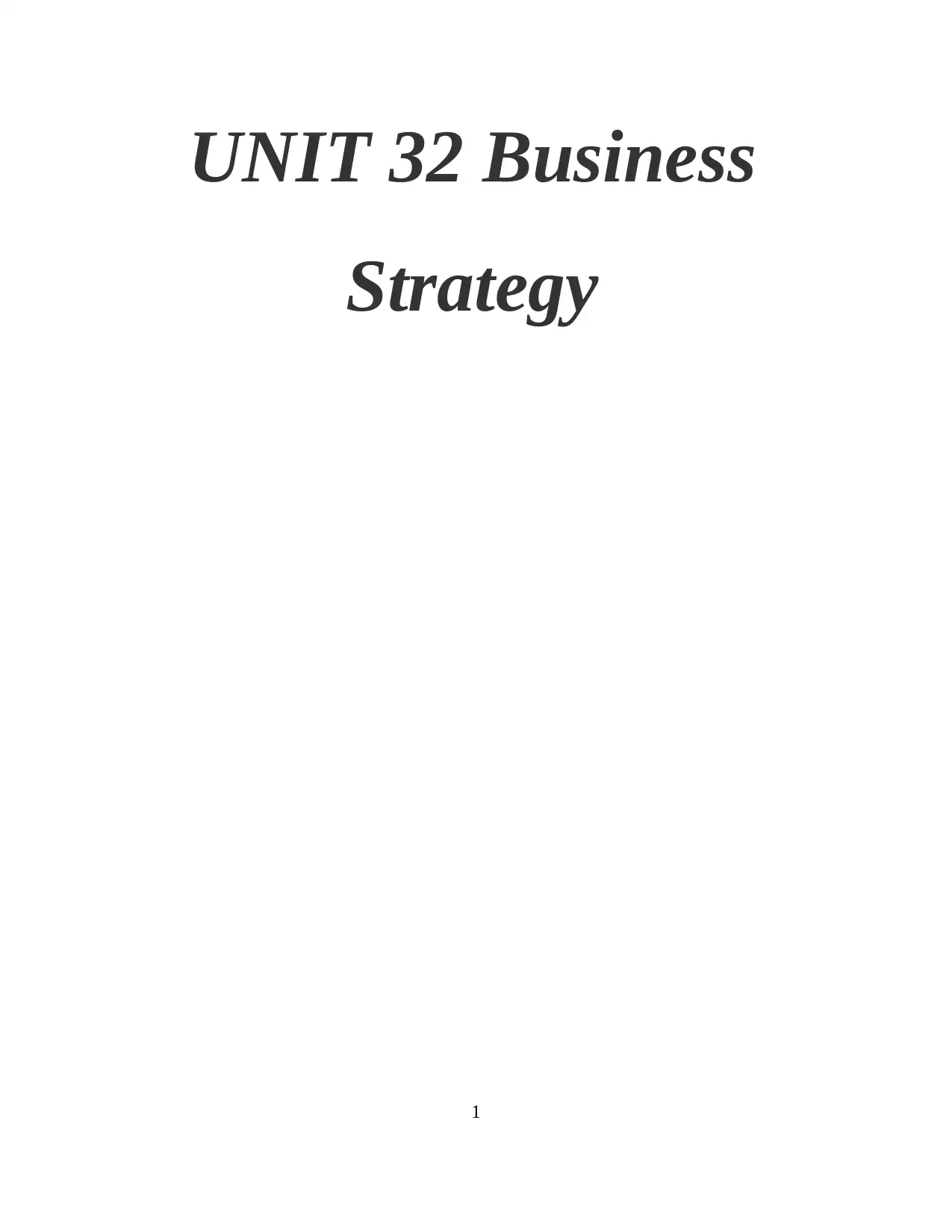
UNIT 32 Business
Strategy
1
Strategy
1
Paraphrase This Document
Need a fresh take? Get an instant paraphrase of this document with our AI Paraphraser
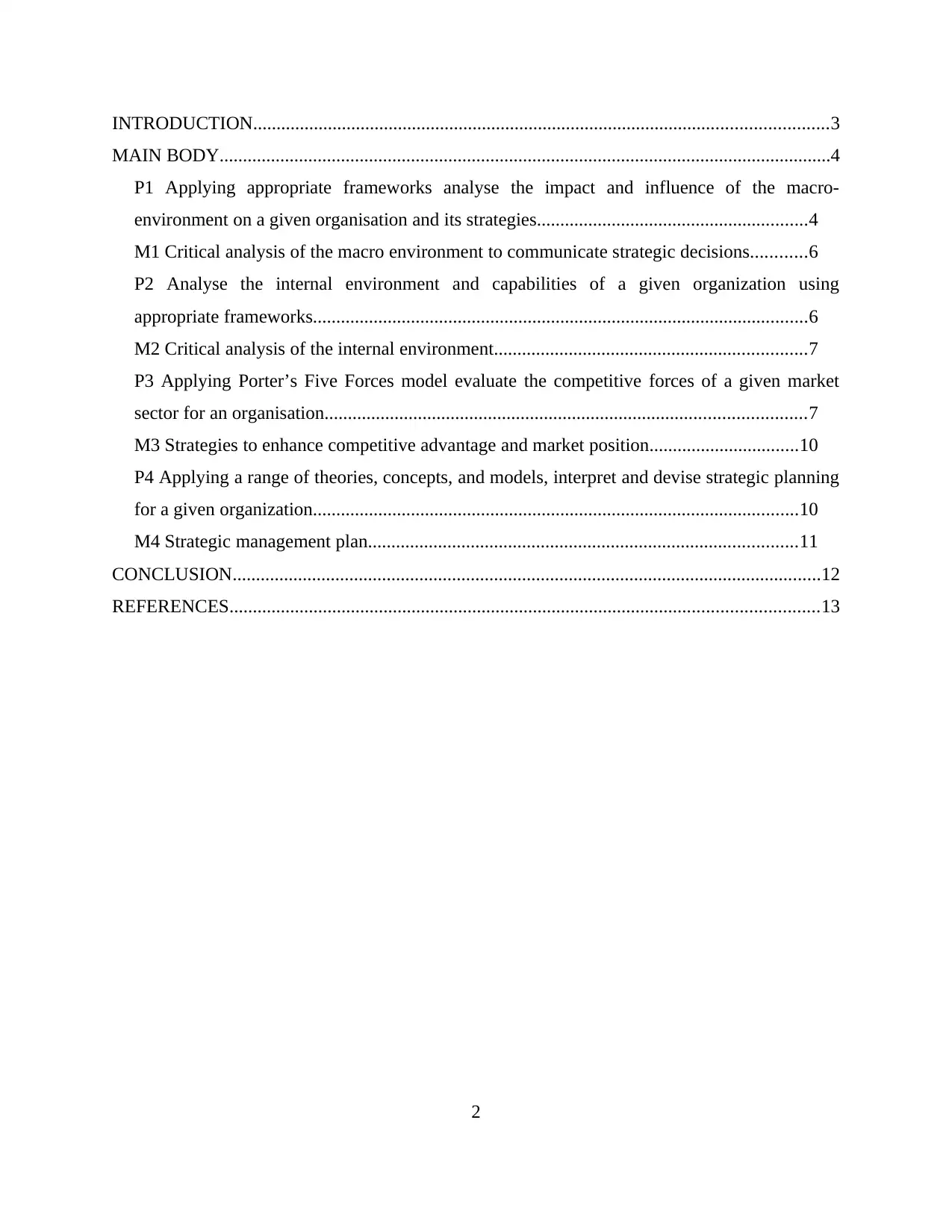
INTRODUCTION...........................................................................................................................3
MAIN BODY...................................................................................................................................4
P1 Applying appropriate frameworks analyse the impact and influence of the macro-
environment on a given organisation and its strategies..........................................................4
M1 Critical analysis of the macro environment to communicate strategic decisions............6
P2 Analyse the internal environment and capabilities of a given organization using
appropriate frameworks..........................................................................................................6
M2 Critical analysis of the internal environment...................................................................7
P3 Applying Porter’s Five Forces model evaluate the competitive forces of a given market
sector for an organisation.......................................................................................................7
M3 Strategies to enhance competitive advantage and market position................................10
P4 Applying a range of theories, concepts, and models, interpret and devise strategic planning
for a given organization........................................................................................................10
M4 Strategic management plan............................................................................................11
CONCLUSION..............................................................................................................................12
REFERENCES..............................................................................................................................13
2
MAIN BODY...................................................................................................................................4
P1 Applying appropriate frameworks analyse the impact and influence of the macro-
environment on a given organisation and its strategies..........................................................4
M1 Critical analysis of the macro environment to communicate strategic decisions............6
P2 Analyse the internal environment and capabilities of a given organization using
appropriate frameworks..........................................................................................................6
M2 Critical analysis of the internal environment...................................................................7
P3 Applying Porter’s Five Forces model evaluate the competitive forces of a given market
sector for an organisation.......................................................................................................7
M3 Strategies to enhance competitive advantage and market position................................10
P4 Applying a range of theories, concepts, and models, interpret and devise strategic planning
for a given organization........................................................................................................10
M4 Strategic management plan............................................................................................11
CONCLUSION..............................................................................................................................12
REFERENCES..............................................................................................................................13
2
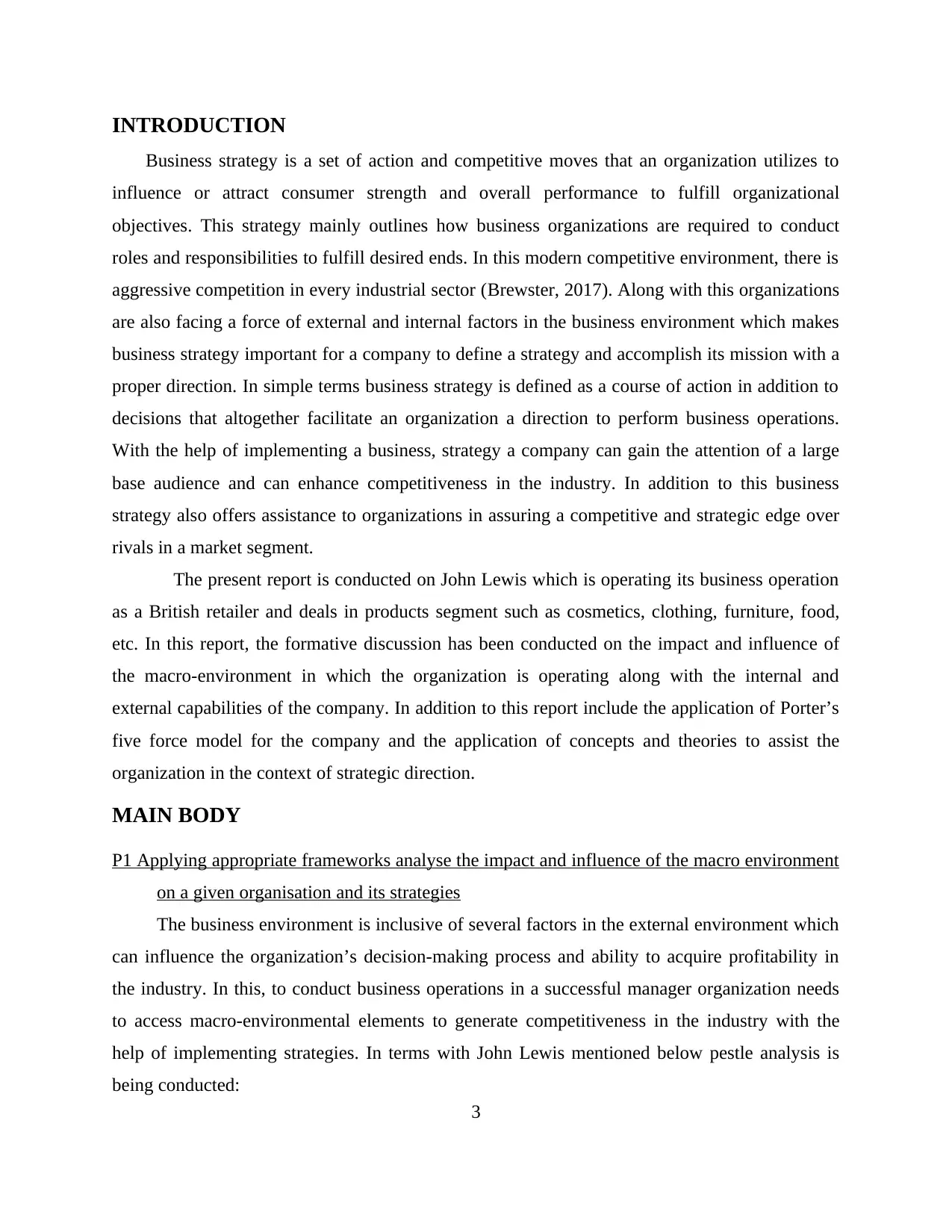
INTRODUCTION
Business strategy is a set of action and competitive moves that an organization utilizes to
influence or attract consumer strength and overall performance to fulfill organizational
objectives. This strategy mainly outlines how business organizations are required to conduct
roles and responsibilities to fulfill desired ends. In this modern competitive environment, there is
aggressive competition in every industrial sector (Brewster, 2017). Along with this organizations
are also facing a force of external and internal factors in the business environment which makes
business strategy important for a company to define a strategy and accomplish its mission with a
proper direction. In simple terms business strategy is defined as a course of action in addition to
decisions that altogether facilitate an organization a direction to perform business operations.
With the help of implementing a business, strategy a company can gain the attention of a large
base audience and can enhance competitiveness in the industry. In addition to this business
strategy also offers assistance to organizations in assuring a competitive and strategic edge over
rivals in a market segment.
The present report is conducted on John Lewis which is operating its business operation
as a British retailer and deals in products segment such as cosmetics, clothing, furniture, food,
etc. In this report, the formative discussion has been conducted on the impact and influence of
the macro-environment in which the organization is operating along with the internal and
external capabilities of the company. In addition to this report include the application of Porter’s
five force model for the company and the application of concepts and theories to assist the
organization in the context of strategic direction.
MAIN BODY
P1 Applying appropriate frameworks analyse the impact and influence of the macro environment
on a given organisation and its strategies
The business environment is inclusive of several factors in the external environment which
can influence the organization’s decision-making process and ability to acquire profitability in
the industry. In this, to conduct business operations in a successful manager organization needs
to access macro-environmental elements to generate competitiveness in the industry with the
help of implementing strategies. In terms with John Lewis mentioned below pestle analysis is
being conducted:
3
Business strategy is a set of action and competitive moves that an organization utilizes to
influence or attract consumer strength and overall performance to fulfill organizational
objectives. This strategy mainly outlines how business organizations are required to conduct
roles and responsibilities to fulfill desired ends. In this modern competitive environment, there is
aggressive competition in every industrial sector (Brewster, 2017). Along with this organizations
are also facing a force of external and internal factors in the business environment which makes
business strategy important for a company to define a strategy and accomplish its mission with a
proper direction. In simple terms business strategy is defined as a course of action in addition to
decisions that altogether facilitate an organization a direction to perform business operations.
With the help of implementing a business, strategy a company can gain the attention of a large
base audience and can enhance competitiveness in the industry. In addition to this business
strategy also offers assistance to organizations in assuring a competitive and strategic edge over
rivals in a market segment.
The present report is conducted on John Lewis which is operating its business operation
as a British retailer and deals in products segment such as cosmetics, clothing, furniture, food,
etc. In this report, the formative discussion has been conducted on the impact and influence of
the macro-environment in which the organization is operating along with the internal and
external capabilities of the company. In addition to this report include the application of Porter’s
five force model for the company and the application of concepts and theories to assist the
organization in the context of strategic direction.
MAIN BODY
P1 Applying appropriate frameworks analyse the impact and influence of the macro environment
on a given organisation and its strategies
The business environment is inclusive of several factors in the external environment which
can influence the organization’s decision-making process and ability to acquire profitability in
the industry. In this, to conduct business operations in a successful manager organization needs
to access macro-environmental elements to generate competitiveness in the industry with the
help of implementing strategies. In terms with John Lewis mentioned below pestle analysis is
being conducted:
3
⊘ This is a preview!⊘
Do you want full access?
Subscribe today to unlock all pages.

Trusted by 1+ million students worldwide
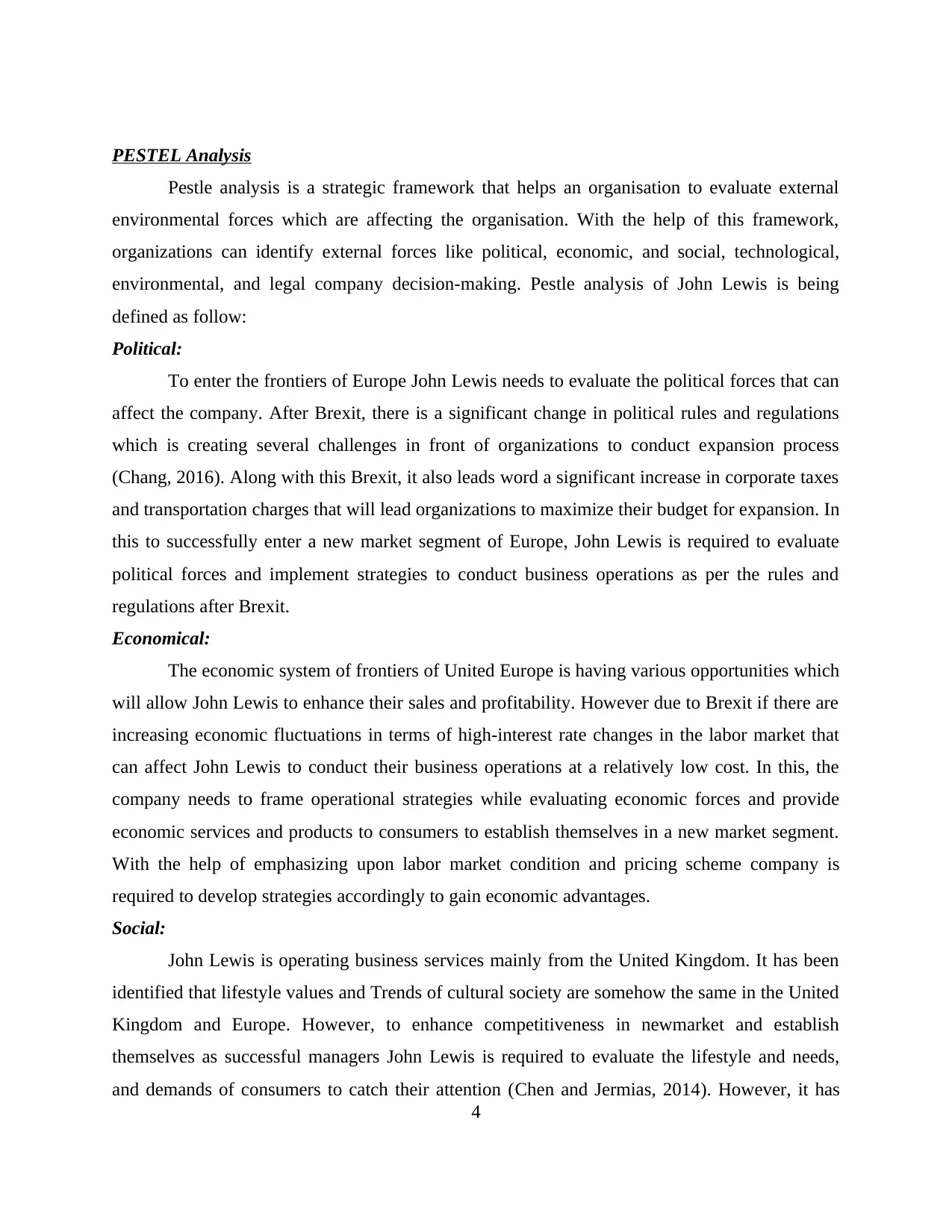
PESTEL Analysis
Pestle analysis is a strategic framework that helps an organisation to evaluate external
environmental forces which are affecting the organisation. With the help of this framework,
organizations can identify external forces like political, economic, and social, technological,
environmental, and legal company decision-making. Pestle analysis of John Lewis is being
defined as follow:
Political:
To enter the frontiers of Europe John Lewis needs to evaluate the political forces that can
affect the company. After Brexit, there is a significant change in political rules and regulations
which is creating several challenges in front of organizations to conduct expansion process
(Chang, 2016). Along with this Brexit, it also leads word a significant increase in corporate taxes
and transportation charges that will lead organizations to maximize their budget for expansion. In
this to successfully enter a new market segment of Europe, John Lewis is required to evaluate
political forces and implement strategies to conduct business operations as per the rules and
regulations after Brexit.
Economical:
The economic system of frontiers of United Europe is having various opportunities which
will allow John Lewis to enhance their sales and profitability. However due to Brexit if there are
increasing economic fluctuations in terms of high-interest rate changes in the labor market that
can affect John Lewis to conduct their business operations at a relatively low cost. In this, the
company needs to frame operational strategies while evaluating economic forces and provide
economic services and products to consumers to establish themselves in a new market segment.
With the help of emphasizing upon labor market condition and pricing scheme company is
required to develop strategies accordingly to gain economic advantages.
Social:
John Lewis is operating business services mainly from the United Kingdom. It has been
identified that lifestyle values and Trends of cultural society are somehow the same in the United
Kingdom and Europe. However, to enhance competitiveness in newmarket and establish
themselves as successful managers John Lewis is required to evaluate the lifestyle and needs,
and demands of consumers to catch their attention (Chen and Jermias, 2014). However, it has
4
Pestle analysis is a strategic framework that helps an organisation to evaluate external
environmental forces which are affecting the organisation. With the help of this framework,
organizations can identify external forces like political, economic, and social, technological,
environmental, and legal company decision-making. Pestle analysis of John Lewis is being
defined as follow:
Political:
To enter the frontiers of Europe John Lewis needs to evaluate the political forces that can
affect the company. After Brexit, there is a significant change in political rules and regulations
which is creating several challenges in front of organizations to conduct expansion process
(Chang, 2016). Along with this Brexit, it also leads word a significant increase in corporate taxes
and transportation charges that will lead organizations to maximize their budget for expansion. In
this to successfully enter a new market segment of Europe, John Lewis is required to evaluate
political forces and implement strategies to conduct business operations as per the rules and
regulations after Brexit.
Economical:
The economic system of frontiers of United Europe is having various opportunities which
will allow John Lewis to enhance their sales and profitability. However due to Brexit if there are
increasing economic fluctuations in terms of high-interest rate changes in the labor market that
can affect John Lewis to conduct their business operations at a relatively low cost. In this, the
company needs to frame operational strategies while evaluating economic forces and provide
economic services and products to consumers to establish themselves in a new market segment.
With the help of emphasizing upon labor market condition and pricing scheme company is
required to develop strategies accordingly to gain economic advantages.
Social:
John Lewis is operating business services mainly from the United Kingdom. It has been
identified that lifestyle values and Trends of cultural society are somehow the same in the United
Kingdom and Europe. However, to enhance competitiveness in newmarket and establish
themselves as successful managers John Lewis is required to evaluate the lifestyle and needs,
and demands of consumers to catch their attention (Chen and Jermias, 2014). However, it has
4
Paraphrase This Document
Need a fresh take? Get an instant paraphrase of this document with our AI Paraphraser
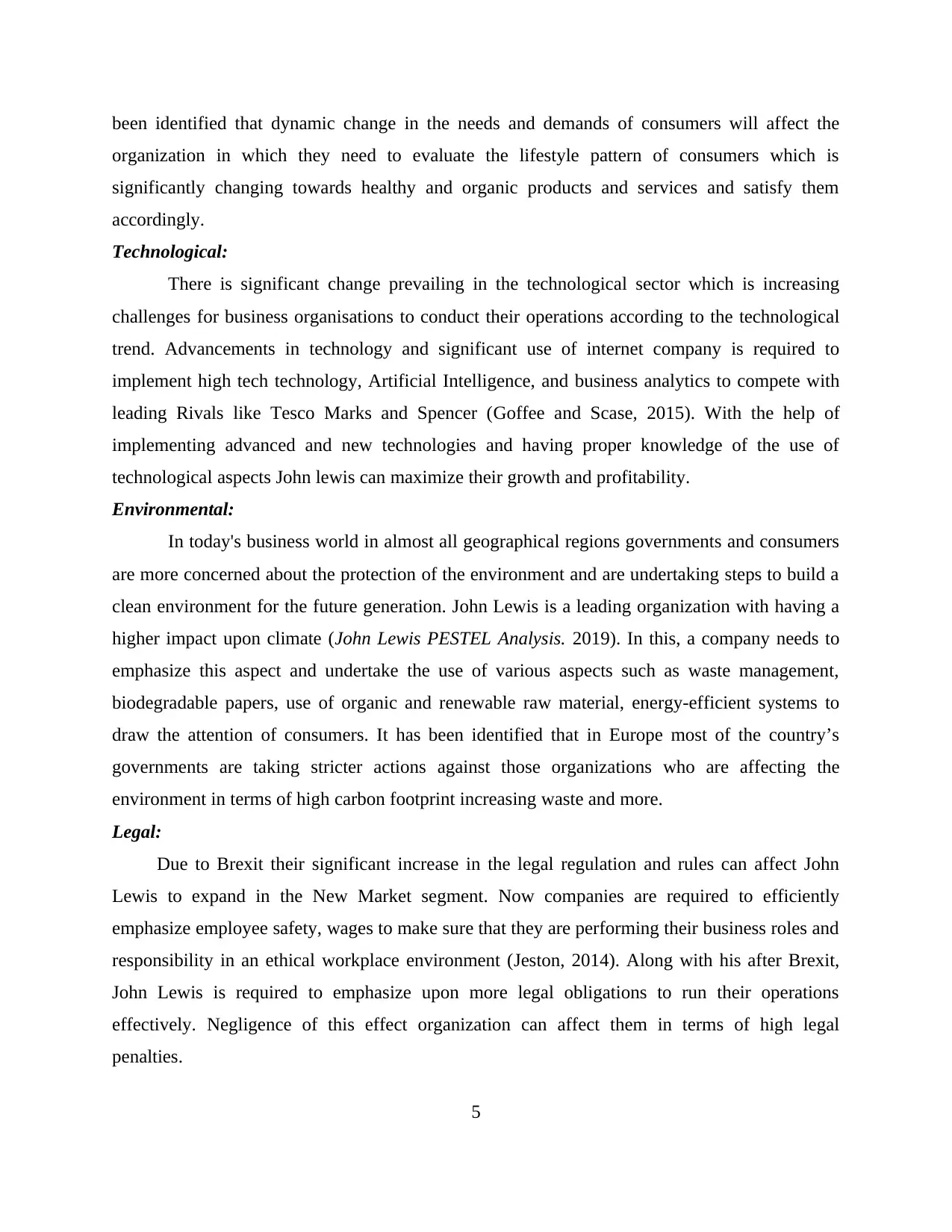
been identified that dynamic change in the needs and demands of consumers will affect the
organization in which they need to evaluate the lifestyle pattern of consumers which is
significantly changing towards healthy and organic products and services and satisfy them
accordingly.
Technological:
There is significant change prevailing in the technological sector which is increasing
challenges for business organisations to conduct their operations according to the technological
trend. Advancements in technology and significant use of internet company is required to
implement high tech technology, Artificial Intelligence, and business analytics to compete with
leading Rivals like Tesco Marks and Spencer (Goffee and Scase, 2015). With the help of
implementing advanced and new technologies and having proper knowledge of the use of
technological aspects John lewis can maximize their growth and profitability.
Environmental:
In today's business world in almost all geographical regions governments and consumers
are more concerned about the protection of the environment and are undertaking steps to build a
clean environment for the future generation. John Lewis is a leading organization with having a
higher impact upon climate (John Lewis PESTEL Analysis. 2019). In this, a company needs to
emphasize this aspect and undertake the use of various aspects such as waste management,
biodegradable papers, use of organic and renewable raw material, energy-efficient systems to
draw the attention of consumers. It has been identified that in Europe most of the country’s
governments are taking stricter actions against those organizations who are affecting the
environment in terms of high carbon footprint increasing waste and more.
Legal:
Due to Brexit their significant increase in the legal regulation and rules can affect John
Lewis to expand in the New Market segment. Now companies are required to efficiently
emphasize employee safety, wages to make sure that they are performing their business roles and
responsibility in an ethical workplace environment (Jeston, 2014). Along with his after Brexit,
John Lewis is required to emphasize upon more legal obligations to run their operations
effectively. Negligence of this effect organization can affect them in terms of high legal
penalties.
5
organization in which they need to evaluate the lifestyle pattern of consumers which is
significantly changing towards healthy and organic products and services and satisfy them
accordingly.
Technological:
There is significant change prevailing in the technological sector which is increasing
challenges for business organisations to conduct their operations according to the technological
trend. Advancements in technology and significant use of internet company is required to
implement high tech technology, Artificial Intelligence, and business analytics to compete with
leading Rivals like Tesco Marks and Spencer (Goffee and Scase, 2015). With the help of
implementing advanced and new technologies and having proper knowledge of the use of
technological aspects John lewis can maximize their growth and profitability.
Environmental:
In today's business world in almost all geographical regions governments and consumers
are more concerned about the protection of the environment and are undertaking steps to build a
clean environment for the future generation. John Lewis is a leading organization with having a
higher impact upon climate (John Lewis PESTEL Analysis. 2019). In this, a company needs to
emphasize this aspect and undertake the use of various aspects such as waste management,
biodegradable papers, use of organic and renewable raw material, energy-efficient systems to
draw the attention of consumers. It has been identified that in Europe most of the country’s
governments are taking stricter actions against those organizations who are affecting the
environment in terms of high carbon footprint increasing waste and more.
Legal:
Due to Brexit their significant increase in the legal regulation and rules can affect John
Lewis to expand in the New Market segment. Now companies are required to efficiently
emphasize employee safety, wages to make sure that they are performing their business roles and
responsibility in an ethical workplace environment (Jeston, 2014). Along with his after Brexit,
John Lewis is required to emphasize upon more legal obligations to run their operations
effectively. Negligence of this effect organization can affect them in terms of high legal
penalties.
5

M1 Critical analysis of the macro environment to communicate strategic decisions
From the Pestle analysis of John Lewis, it has been identified that there are some negative
factors associated with macro-environmental elements which are affecting John Lewis’s business
operations. Pestel’s analysis state that Brexit affects the company in terms of economic and
political fluctuations. Along with this changes in consumers lifestyle and trends (social) and lack
of knowledge of the company in terms with the latest technology (technological), and non-
compliance with a legal obligation (legal) and not acting in the interest of the
environment(environmental) are some critical impacts of macro factors which are affecting the
company. In this, the management of John Lewis needs to emphasize microenvironmental
factors and develop strategies accordingly.
P2 Analyse the internal environment and capabilities of a given organization using appropriate
frameworks
To successfully operate in in any industry, it is essential for an organisation’s internal
environment in order to identify the capabilities and strengths of the company in order to cope up
with the external forces. SWOT analysis plays an essential role which assists the company to
identify the capability as a strength and evaluating weaknesses and threads and take advantage of
opportunities to fulfill with overall growth in the industry. Mentioned below SWOT analysis of
John Lewis is conducted:
SWOT Analysis:
Strength Weakness
John Lewis is a leading organization in
the retail industrial sector with a strong
brand image in the market which
influences the mindset of consumers
towards company products and
services.
John Lewis is having will build online
existence and offer products and
services with eye-catching trends
Weakness which is affecting John
Lewis is lack of knowledge in
international business understanding, as
compared to other rivals in industry
John Lewis is making fewer
investments in international expansion.
John Lewis also lacks investing in
successful marketing strategies such as
digital marketing which is decreasing
6
From the Pestle analysis of John Lewis, it has been identified that there are some negative
factors associated with macro-environmental elements which are affecting John Lewis’s business
operations. Pestel’s analysis state that Brexit affects the company in terms of economic and
political fluctuations. Along with this changes in consumers lifestyle and trends (social) and lack
of knowledge of the company in terms with the latest technology (technological), and non-
compliance with a legal obligation (legal) and not acting in the interest of the
environment(environmental) are some critical impacts of macro factors which are affecting the
company. In this, the management of John Lewis needs to emphasize microenvironmental
factors and develop strategies accordingly.
P2 Analyse the internal environment and capabilities of a given organization using appropriate
frameworks
To successfully operate in in any industry, it is essential for an organisation’s internal
environment in order to identify the capabilities and strengths of the company in order to cope up
with the external forces. SWOT analysis plays an essential role which assists the company to
identify the capability as a strength and evaluating weaknesses and threads and take advantage of
opportunities to fulfill with overall growth in the industry. Mentioned below SWOT analysis of
John Lewis is conducted:
SWOT Analysis:
Strength Weakness
John Lewis is a leading organization in
the retail industrial sector with a strong
brand image in the market which
influences the mindset of consumers
towards company products and
services.
John Lewis is having will build online
existence and offer products and
services with eye-catching trends
Weakness which is affecting John
Lewis is lack of knowledge in
international business understanding, as
compared to other rivals in industry
John Lewis is making fewer
investments in international expansion.
John Lewis also lacks investing in
successful marketing strategies such as
digital marketing which is decreasing
6
⊘ This is a preview!⊘
Do you want full access?
Subscribe today to unlock all pages.

Trusted by 1+ million students worldwide
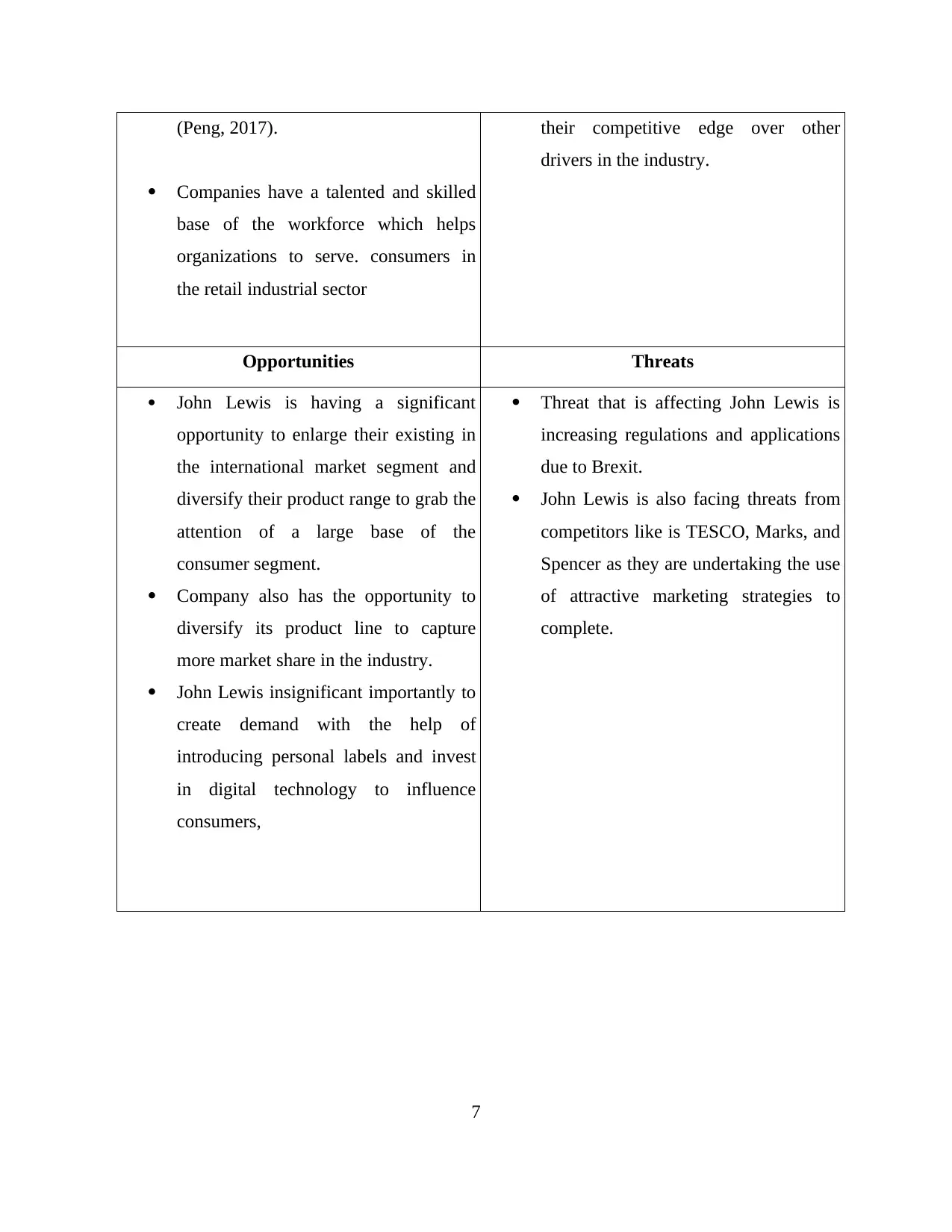
(Peng, 2017).
Companies have a talented and skilled
base of the workforce which helps
organizations to serve. consumers in
the retail industrial sector
their competitive edge over other
drivers in the industry.
Opportunities Threats
John Lewis is having a significant
opportunity to enlarge their existing in
the international market segment and
diversify their product range to grab the
attention of a large base of the
consumer segment.
Company also has the opportunity to
diversify its product line to capture
more market share in the industry.
John Lewis insignificant importantly to
create demand with the help of
introducing personal labels and invest
in digital technology to influence
consumers,
Threat that is affecting John Lewis is
increasing regulations and applications
due to Brexit.
John Lewis is also facing threats from
competitors like is TESCO, Marks, and
Spencer as they are undertaking the use
of attractive marketing strategies to
complete.
7
Companies have a talented and skilled
base of the workforce which helps
organizations to serve. consumers in
the retail industrial sector
their competitive edge over other
drivers in the industry.
Opportunities Threats
John Lewis is having a significant
opportunity to enlarge their existing in
the international market segment and
diversify their product range to grab the
attention of a large base of the
consumer segment.
Company also has the opportunity to
diversify its product line to capture
more market share in the industry.
John Lewis insignificant importantly to
create demand with the help of
introducing personal labels and invest
in digital technology to influence
consumers,
Threat that is affecting John Lewis is
increasing regulations and applications
due to Brexit.
John Lewis is also facing threats from
competitors like is TESCO, Marks, and
Spencer as they are undertaking the use
of attractive marketing strategies to
complete.
7
Paraphrase This Document
Need a fresh take? Get an instant paraphrase of this document with our AI Paraphraser
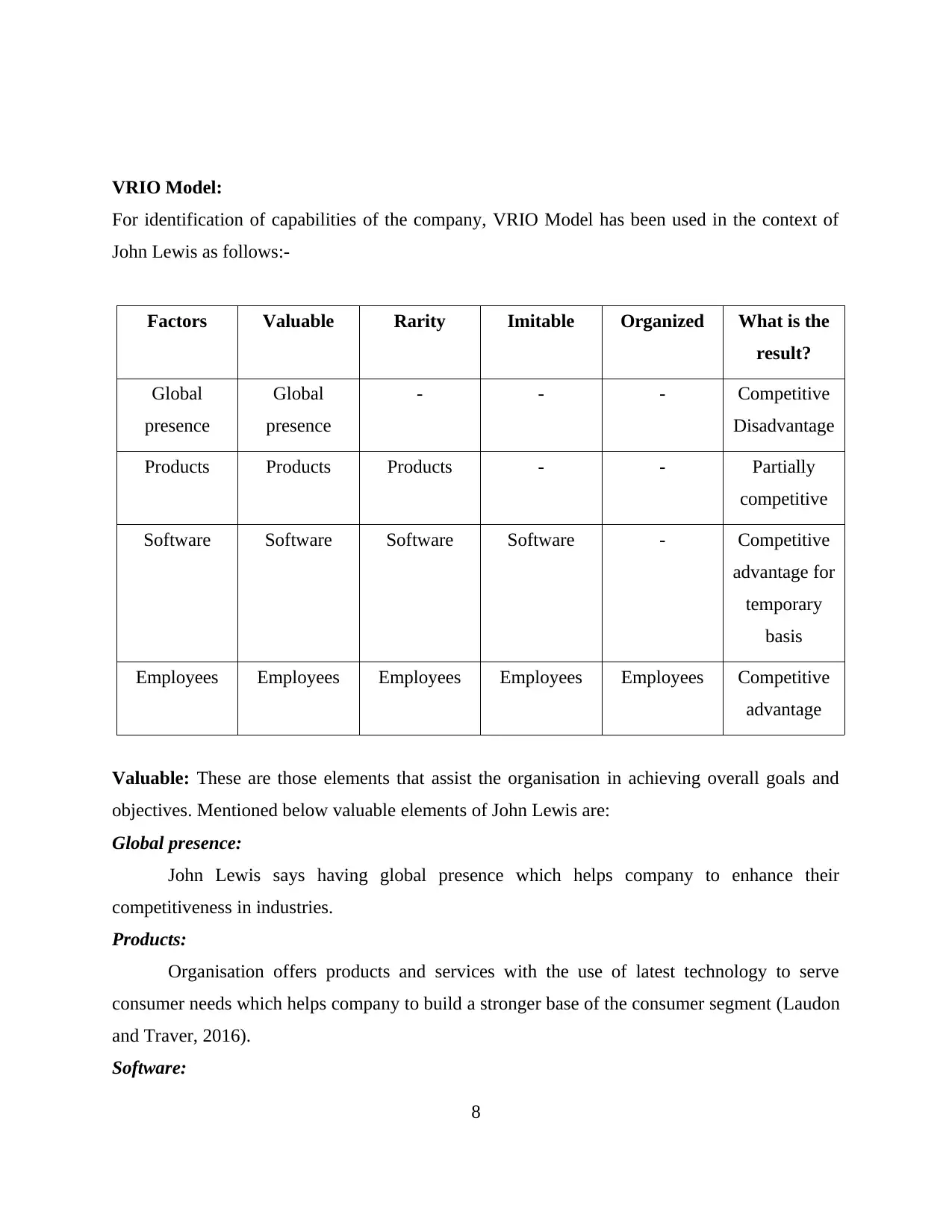
VRIO Model:
For identification of capabilities of the company, VRIO Model has been used in the context of
John Lewis as follows:-
Factors Valuable Rarity Imitable Organized What is the
result?
Global
presence
Global
presence
- - - Competitive
Disadvantage
Products Products Products - - Partially
competitive
Software Software Software Software - Competitive
advantage for
temporary
basis
Employees Employees Employees Employees Employees Competitive
advantage
Valuable: These are those elements that assist the organisation in achieving overall goals and
objectives. Mentioned below valuable elements of John Lewis are:
Global presence:
John Lewis says having global presence which helps company to enhance their
competitiveness in industries.
Products:
Organisation offers products and services with the use of latest technology to serve
consumer needs which helps company to build a stronger base of the consumer segment (Laudon
and Traver, 2016).
Software:
8
For identification of capabilities of the company, VRIO Model has been used in the context of
John Lewis as follows:-
Factors Valuable Rarity Imitable Organized What is the
result?
Global
presence
Global
presence
- - - Competitive
Disadvantage
Products Products Products - - Partially
competitive
Software Software Software Software - Competitive
advantage for
temporary
basis
Employees Employees Employees Employees Employees Competitive
advantage
Valuable: These are those elements that assist the organisation in achieving overall goals and
objectives. Mentioned below valuable elements of John Lewis are:
Global presence:
John Lewis says having global presence which helps company to enhance their
competitiveness in industries.
Products:
Organisation offers products and services with the use of latest technology to serve
consumer needs which helps company to build a stronger base of the consumer segment (Laudon
and Traver, 2016).
Software:
8

John Lewis undertakes use of software to manage and operate things in an effective
manner to accomplish organizational objectives.
Employees:
John Lewis’s staff is highly talented and skilled which provides organisation competitive
edge in the industry to serve consumers.
Rarity: It is defined as element in which a company have certain aspects which is rare and
provide them a competitive edge industry. In terms with John Lewis’s global presence is not
rare, as company rivals are having a stronger global presence which is decreasing the
competitive edge of the company.
Products: Products offered by this organization are by the latest trends and technologies,
thus, it is hard for any other company to easily copy them. Software: The software used by John Lewis Ltd for maintenance of records and
execution of operations is rare because it is developed as per the requirements of the
entity.
Employees: The employees of John Lewis are rare as they have their own set of skills
and competence which assists organizations in achievement of organizational objectives
in an effective manner.
Imitable: It refers to those resources of a company that can not be copied by rivals. For John
Lewis, products do not hold this feature as the trends and technologies with which these are
developed can be used by rivals also. Software: Software used by John Lewis is designed and developed by organizational
needs, thus, it is hard to be copied.
Employees: The skills and knowledge of the staff are unique to individuals owing to the
training provided to them and their traits, thus these can not be copied by rivals.
Organized: It can be referred to as the elements which need to be organized in an orderly
manner to attain organizational goals and objectives. The software of John Lewis has to be
updated at regular intervals to meet the needs of the organization thus it does not fit this criterion.
9
manner to accomplish organizational objectives.
Employees:
John Lewis’s staff is highly talented and skilled which provides organisation competitive
edge in the industry to serve consumers.
Rarity: It is defined as element in which a company have certain aspects which is rare and
provide them a competitive edge industry. In terms with John Lewis’s global presence is not
rare, as company rivals are having a stronger global presence which is decreasing the
competitive edge of the company.
Products: Products offered by this organization are by the latest trends and technologies,
thus, it is hard for any other company to easily copy them. Software: The software used by John Lewis Ltd for maintenance of records and
execution of operations is rare because it is developed as per the requirements of the
entity.
Employees: The employees of John Lewis are rare as they have their own set of skills
and competence which assists organizations in achievement of organizational objectives
in an effective manner.
Imitable: It refers to those resources of a company that can not be copied by rivals. For John
Lewis, products do not hold this feature as the trends and technologies with which these are
developed can be used by rivals also. Software: Software used by John Lewis is designed and developed by organizational
needs, thus, it is hard to be copied.
Employees: The skills and knowledge of the staff are unique to individuals owing to the
training provided to them and their traits, thus these can not be copied by rivals.
Organized: It can be referred to as the elements which need to be organized in an orderly
manner to attain organizational goals and objectives. The software of John Lewis has to be
updated at regular intervals to meet the needs of the organization thus it does not fit this criterion.
9
⊘ This is a preview!⊘
Do you want full access?
Subscribe today to unlock all pages.

Trusted by 1+ million students worldwide
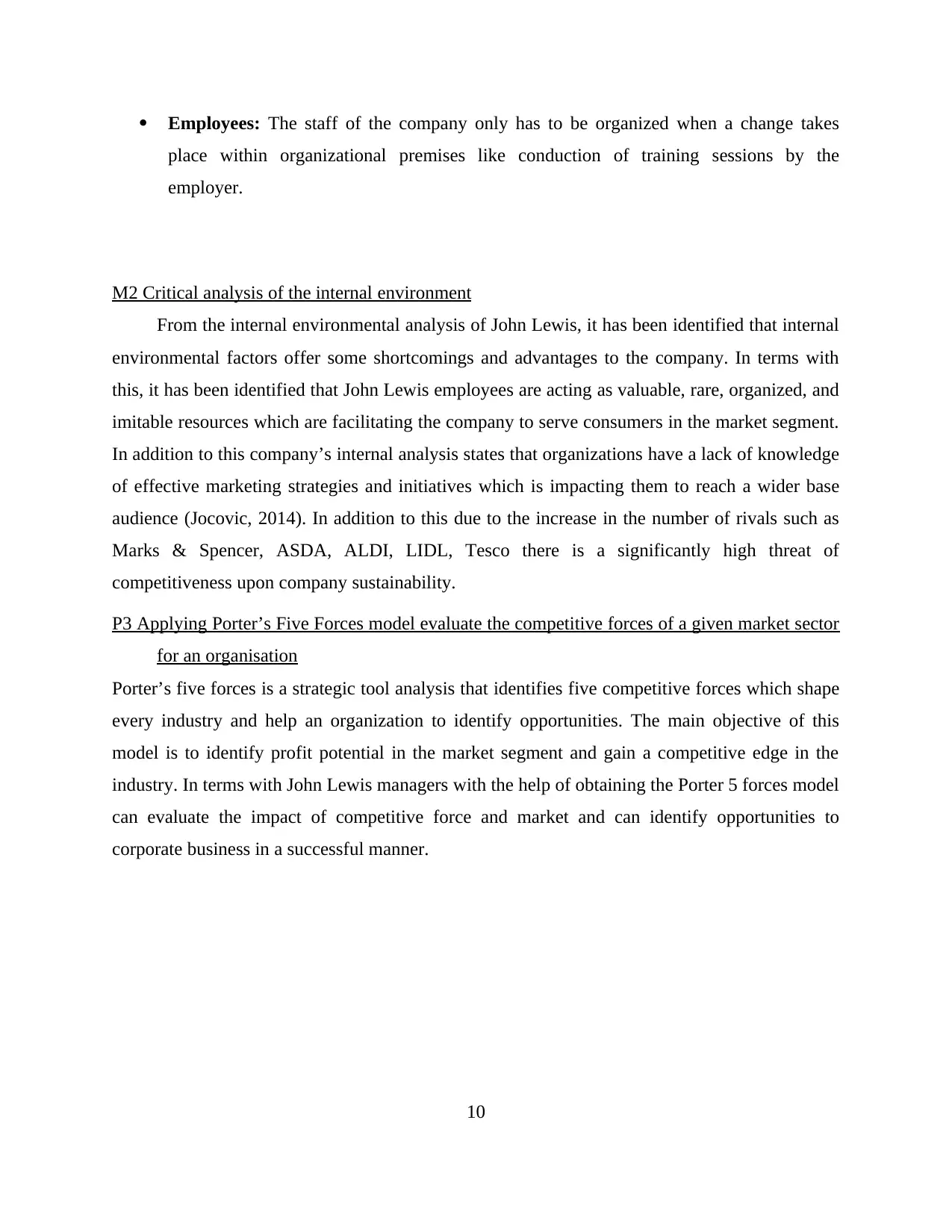
Employees: The staff of the company only has to be organized when a change takes
place within organizational premises like conduction of training sessions by the
employer.
M2 Critical analysis of the internal environment
From the internal environmental analysis of John Lewis, it has been identified that internal
environmental factors offer some shortcomings and advantages to the company. In terms with
this, it has been identified that John Lewis employees are acting as valuable, rare, organized, and
imitable resources which are facilitating the company to serve consumers in the market segment.
In addition to this company’s internal analysis states that organizations have a lack of knowledge
of effective marketing strategies and initiatives which is impacting them to reach a wider base
audience (Jocovic, 2014). In addition to this due to the increase in the number of rivals such as
Marks & Spencer, ASDA, ALDI, LIDL, Tesco there is a significantly high threat of
competitiveness upon company sustainability.
P3 Applying Porter’s Five Forces model evaluate the competitive forces of a given market sector
for an organisation
Porter’s five forces is a strategic tool analysis that identifies five competitive forces which shape
every industry and help an organization to identify opportunities. The main objective of this
model is to identify profit potential in the market segment and gain a competitive edge in the
industry. In terms with John Lewis managers with the help of obtaining the Porter 5 forces model
can evaluate the impact of competitive force and market and can identify opportunities to
corporate business in a successful manner.
10
place within organizational premises like conduction of training sessions by the
employer.
M2 Critical analysis of the internal environment
From the internal environmental analysis of John Lewis, it has been identified that internal
environmental factors offer some shortcomings and advantages to the company. In terms with
this, it has been identified that John Lewis employees are acting as valuable, rare, organized, and
imitable resources which are facilitating the company to serve consumers in the market segment.
In addition to this company’s internal analysis states that organizations have a lack of knowledge
of effective marketing strategies and initiatives which is impacting them to reach a wider base
audience (Jocovic, 2014). In addition to this due to the increase in the number of rivals such as
Marks & Spencer, ASDA, ALDI, LIDL, Tesco there is a significantly high threat of
competitiveness upon company sustainability.
P3 Applying Porter’s Five Forces model evaluate the competitive forces of a given market sector
for an organisation
Porter’s five forces is a strategic tool analysis that identifies five competitive forces which shape
every industry and help an organization to identify opportunities. The main objective of this
model is to identify profit potential in the market segment and gain a competitive edge in the
industry. In terms with John Lewis managers with the help of obtaining the Porter 5 forces model
can evaluate the impact of competitive force and market and can identify opportunities to
corporate business in a successful manner.
10
Paraphrase This Document
Need a fresh take? Get an instant paraphrase of this document with our AI Paraphraser
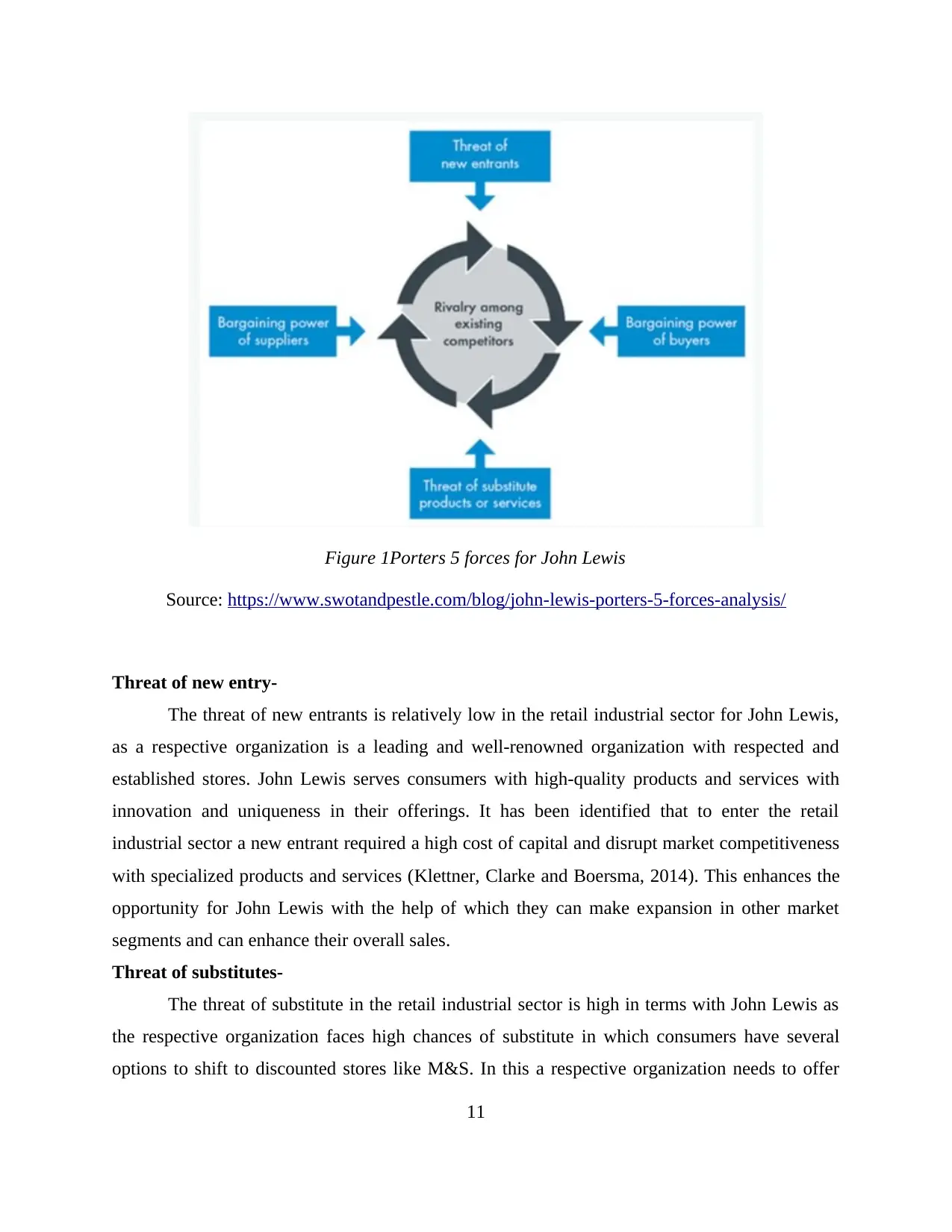
Figure 1Porters 5 forces for John Lewis
Source: https://www.swotandpestle.com/blog/john-lewis-porters-5-forces-analysis/
Threat of new entry-
The threat of new entrants is relatively low in the retail industrial sector for John Lewis,
as a respective organization is a leading and well-renowned organization with respected and
established stores. John Lewis serves consumers with high-quality products and services with
innovation and uniqueness in their offerings. It has been identified that to enter the retail
industrial sector a new entrant required a high cost of capital and disrupt market competitiveness
with specialized products and services (Klettner, Clarke and Boersma, 2014). This enhances the
opportunity for John Lewis with the help of which they can make expansion in other market
segments and can enhance their overall sales.
Threat of substitutes-
The threat of substitute in the retail industrial sector is high in terms with John Lewis as
the respective organization faces high chances of substitute in which consumers have several
options to shift to discounted stores like M&S. In this a respective organization needs to offer
11
Source: https://www.swotandpestle.com/blog/john-lewis-porters-5-forces-analysis/
Threat of new entry-
The threat of new entrants is relatively low in the retail industrial sector for John Lewis,
as a respective organization is a leading and well-renowned organization with respected and
established stores. John Lewis serves consumers with high-quality products and services with
innovation and uniqueness in their offerings. It has been identified that to enter the retail
industrial sector a new entrant required a high cost of capital and disrupt market competitiveness
with specialized products and services (Klettner, Clarke and Boersma, 2014). This enhances the
opportunity for John Lewis with the help of which they can make expansion in other market
segments and can enhance their overall sales.
Threat of substitutes-
The threat of substitute in the retail industrial sector is high in terms with John Lewis as
the respective organization faces high chances of substitute in which consumers have several
options to shift to discounted stores like M&S. In this a respective organization needs to offer
11

low priced products and tackle situations with the help of product specialization flexible pricing
strategy to gain profitability.
Bargaining power of customers-
The bargaining power of buyers is high in the retail industry sector. In context with John
Lewis as there are several organizations like Tesco, Sainsbury, Marks, and Spencer those who
are taking advantage of competitive pricing strategy and offer innovative products and services
to consumers. This is leading towards an increase in competition which is affecting John Lewis
sales and profitability. In this, companies need to lower the price and enhance their consumer
while expanding on the international market segment.
Bargaining power of suppliers-
The bargaining power of suppliers is relatively high in the retail industry. John Lewis is
an effective organization which is having the upper hand over suppliers in which every supplier
in this industrial sector aims to perform their business operations for John Lewis. It has been
identified that John Lewis is one of the United Kingdom’s major retailers with good turnover and
high sales and a large number of consumers with enhanced company negotiation power over
suppliers (Laudon and Traver, 2016). This company with the help of taking advantage of a
strong supplier network can make expansion in the new product line and can offer them in a new
market segment to maximize their competitive growth.
Competitive rivalry-
The threat of rivalry is high in the retail industrial sector in which John Lewis is facing
high competition from leading organizations like Marks and Spencer, ASDA, etc. In this, it has
been identified that major competitors of companies like Tesco and Sainsbury are making
significant diversification in their clothing and household goods segment which is enhancing
competitive force for John Lewis (Lawton, 2017). In this, a company needs to undertake the
opportunity of low-cost pricing strategy and diversify in other product lines and make its position
in the new market segment to enhance its international competitive edge and overcome the threat
of rivalry.
According to the above-mentioned water analysis, it has been identified that it is essential
for company leaders and managers to implement appropriate strategies and have a strong market
plan to offer new products and services to consumers, to ensure long-term sustainability and gain
competitiveness in the industry.
12
strategy to gain profitability.
Bargaining power of customers-
The bargaining power of buyers is high in the retail industry sector. In context with John
Lewis as there are several organizations like Tesco, Sainsbury, Marks, and Spencer those who
are taking advantage of competitive pricing strategy and offer innovative products and services
to consumers. This is leading towards an increase in competition which is affecting John Lewis
sales and profitability. In this, companies need to lower the price and enhance their consumer
while expanding on the international market segment.
Bargaining power of suppliers-
The bargaining power of suppliers is relatively high in the retail industry. John Lewis is
an effective organization which is having the upper hand over suppliers in which every supplier
in this industrial sector aims to perform their business operations for John Lewis. It has been
identified that John Lewis is one of the United Kingdom’s major retailers with good turnover and
high sales and a large number of consumers with enhanced company negotiation power over
suppliers (Laudon and Traver, 2016). This company with the help of taking advantage of a
strong supplier network can make expansion in the new product line and can offer them in a new
market segment to maximize their competitive growth.
Competitive rivalry-
The threat of rivalry is high in the retail industrial sector in which John Lewis is facing
high competition from leading organizations like Marks and Spencer, ASDA, etc. In this, it has
been identified that major competitors of companies like Tesco and Sainsbury are making
significant diversification in their clothing and household goods segment which is enhancing
competitive force for John Lewis (Lawton, 2017). In this, a company needs to undertake the
opportunity of low-cost pricing strategy and diversify in other product lines and make its position
in the new market segment to enhance its international competitive edge and overcome the threat
of rivalry.
According to the above-mentioned water analysis, it has been identified that it is essential
for company leaders and managers to implement appropriate strategies and have a strong market
plan to offer new products and services to consumers, to ensure long-term sustainability and gain
competitiveness in the industry.
12
⊘ This is a preview!⊘
Do you want full access?
Subscribe today to unlock all pages.

Trusted by 1+ million students worldwide
1 out of 17
Related Documents
Your All-in-One AI-Powered Toolkit for Academic Success.
+13062052269
info@desklib.com
Available 24*7 on WhatsApp / Email
![[object Object]](/_next/static/media/star-bottom.7253800d.svg)
Unlock your academic potential
Copyright © 2020–2025 A2Z Services. All Rights Reserved. Developed and managed by ZUCOL.





